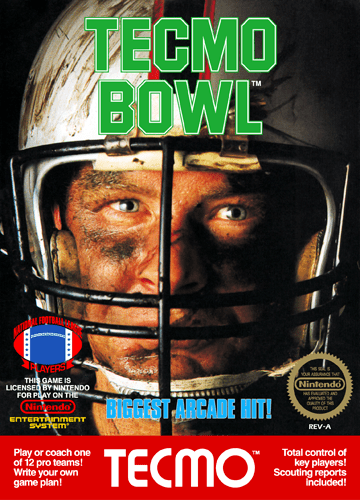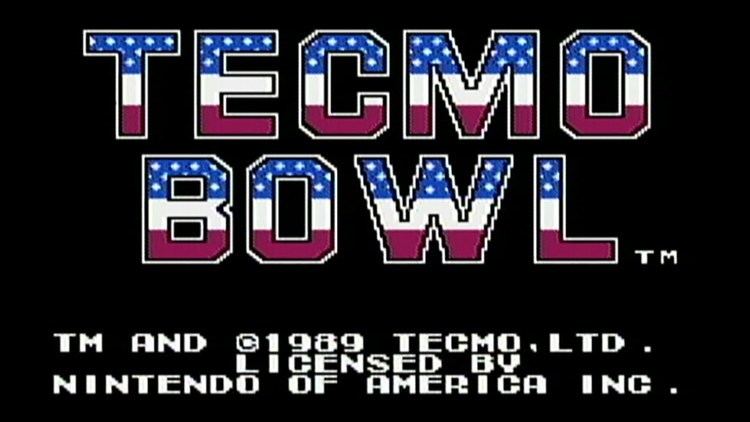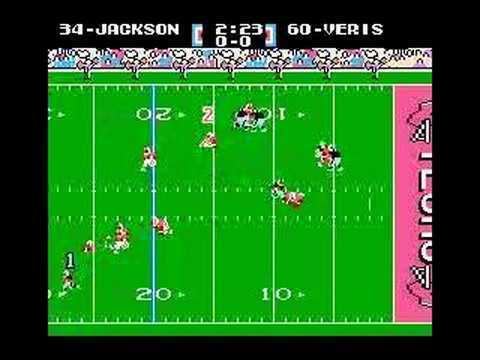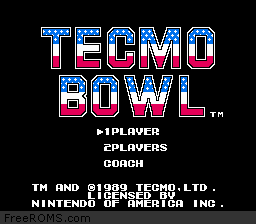9 /10 1 Votes9
| 4.5/5 Emuparadise Genre(s) American football Initial release date 1987 | |||||||||||||||||||||||||||||||||
CPU Main: 2× Z80 @ 8 MHzSound: Z80 @ 4 MHz Sound 2× YM3812 @ 4 MHz,2× MSM5205 @ 384 kHz Developers Tecmo, Acclaim Studios Salt Lake City Platforms Publishers Tecmo, Nintendo, Koei Tecmo Similar Tecmo games, American football games, Other games | ||||||||||||||||||||||||||||||||||
Tecmo bowl arcade version 1
Tecmo Bowl (Japanese: テクモボウル, Hepburn: Tekumo Bōru) is an American football arcade game developed and released by Tecmo in 1987. The game was successful in its original arcade format, and as a 1989 port for the Nintendo Entertainment System. The NES version is the first console game to have featured real NFL players. Although LJN's NFL is the first NES game to have featured NFL team names, it was not as successful as Tecmo Bowl. Because of this, and combined with the scarcity of the arcade version, the NES version eclipsed its arcade counterpart in popularity. The NES version was ported to mobile phones in 2004—and then to the North American Virtual Console: March 12, 2007 for the Wii, September 12, 2013 for the Nintendo 3DS, and on September 10, 2015 for the Wii U. The game was also included on the NES Classic Edition, which launched in 2016. The arcade version for the Wii Virtual Console was released in North America on August 3, 2009 and in Japan on September 29, 2009. The game is notorious for how much better Los Angeles Raiders running back Bo Jackson is than the rest of the players in the game, as he can make it through the defense almost every time.
Contents
- Tecmo bowl arcade version 1
- Tecmo bowl arcade
- Gameplay
- Teams
- Related releases
- Reception
- In popular culture
- References
Tecmo bowl arcade
Gameplay

The original arcade version is distinguished by a large two-monitor cabinet, support for up to four players, and the ability to break tackles. Only two fictional teams can be chosen: the Wildcats and the Bulldogs. The 2D graphics are also more advanced than the NES version, with the arcade original having a larger color palette and more detailed sprites.

The NES version allows two players rather than the arcade's four players. The player can choose between three modes: one-player, two-player, and coach. In one-player mode, the player picks a football team and plays against the computer. After every game that the player wins, the computer picks another team to play as, and the player stays with the original choice. In the two-player and coach modes, the player and another human will play one game but the players only choose the plays in the coach mode (which cannot be done in the arcade version).

In both versions, the playbook consists of only four offensive plays. When on defense, a player selects a play based on the anticipation of the offense's choice; if chosen correctly, it results in a collapse of the offensive line and well-covered receivers, therefore setting up either a potential sack or an interception.

Although featuring the names and statistics of real NFL players from the 1988 NFL season, the gameplay limits how closely the video game players mimicks real life players. Unlike the NFL, the arcade version only allows ten players for each team on the field at a time and the NES version only consists of nine on each side. The offensive player with the ball tries to avoid the defenders, the defenders tries to avoid blockers and catch the player with the ball.
Teams
Tecmo Bowl contains twelve teams, each equipped with four plays. Most teams have two running plays and two passing plays. The exceptions are San Francisco and Miami, who have three passing plays and one running play.
Tecmo was not able to get the NFL's consent to use real team names. As a result, the teams in the game are identified solely by their home city or state. However, each roster mimics that of the NFL team based out of the same city or state. Tecmo Bowl only uses players from twelve of the best and most popular teams.
The teams mimicked in the game are Indianapolis, Miami, Cleveland, Denver, Seattle, Los Angeles (Raiders), Washington, San Francisco, Dallas, New York (Giants), Chicago, and Minnesota.
Each team has a different level of effectiveness based on its personnel and play selection.
There were two NES versions of the game released in the U.S. The first release is identified by its black and gold seal of quality and the second version by its white and gold seal. The original Tecmo Bowl for the NES features Eric Dickerson as running back and Albert Bentley as kick returner for Indianapolis. A later version that was released had Albert Bentley as running back and Clarence Verdin as kick returner, instead. A year later, the Japanese NES Famicom version of Tecmo Bowl has many roster changes that are included in the game to reflect the year it was released.
Related releases
The 2007 and 2013 Virtual Console releases contain a modified version of the game without the NFLPA license, since EA owns exclusive rights to it; thus, the players are represented only by number and not by name. The original arcade version was featured in Tecmo Classic Arcade for the Xbox.
Reception
In the September 1997 issue of Nintendo Power, twelve staff members voted in a list for the top 100 games of all time, putting Tecmo Bowl at 30th place. Time listed Tecmo Bowl for the NES in its list of All-Time 100 Video Games. Time noted that the game's arcade-like controls and "quasi-realistic teams and players" made the game a "breakout hit that’s still fun to pick up and play to this very day."
TechTimes noted that the game's character of Bo Jackson is "[a]bsolutely, positively—and absurdly—unstoppable". Said to apparently reflect the real Bo Jackson's extraordinary athletic abilities, this character can be effectively used as a means of cheating within the game.
In popular culture
Gameplay is featured in the Family Guy episode "Run, Chris, Run", where Peter uses Bo Jackson to beat Quagmire.
Tecmo Bowl is a central theme for two 2016 Kia Sorento commercials. Both commercials star the aforementioned Bo Jackson and play off the ridiculously advantageous characteristics he possesses in the game. One also features Brian Bosworth, who was famously run over by Jackson during a Monday Night Football game in 1987 as he attempted to score a touchdown.
